NASA Ames Astrogram – September/October 2023

NASA Ames’ Contributions to OSIRIS-REx
by Gianine Figliozzi
Extraterrestrial rocks and dust – material scooped up from an asteroid – were delivered to Earth on Sept. 24, 2023. A safe landing in the Utah desert for the spacecraft carrying this bounty marked the end of a seven-year journey for NASA’s OSIRIS-REx – short for the Origins, Spectral Interpretation, Resource Identification, and Security-Regolith Explorer – and the start of two intensive years of sample analysis activities for mission scientists on Earth.
Over the coming decades, scientists around the world will study the rocks and dust collected from the asteroid Bennu to learn about the formation of the solar system and the delivery of organic molecules to early Earth.
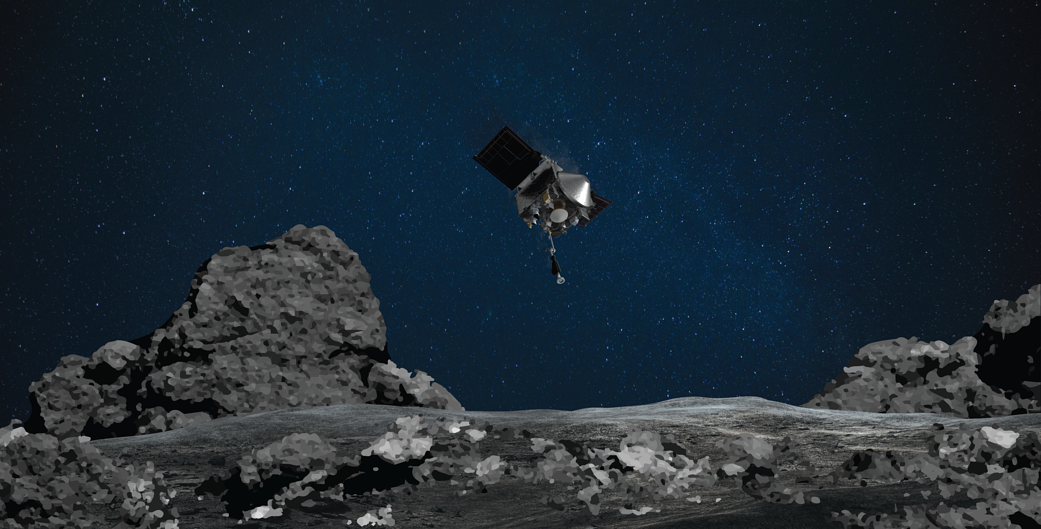
Bennu is also one of the most potentially hazardous asteroids for Earth impact, although the chances of impact in the 22nd century are only one in 1,750. Understanding the physical and chemical properties of asteroids like Bennu will be critical, should humanity need to mitigate impact hazards in the future.
Teams at NASA Ames have played critical roles in preparing the mission for success and will continue to work on the OSIRIS-REx samples once they arrive. They helped design ways for the mission to collect high-quality samples, preserve them in pristine form, and develop a plan for the scientific community to study the essentially irreplaceable asteroid material. Ames experts also advised the mission on its thermal protection system – notably the heat shield that will protect the sample return capsule from the blistering heat of passing through Earth’s atmosphere.
Read on for more details of Ames’ contributions to OSIRIS-REx.
Preparing for an Asteroid Sample: From Canister to Curation
Ames researcher Scott Sandford has been involved with OSIRIS-REx since the earliest days of the mission. A major area of his work was in the design and testing of the air filter system on the sample return canister that has housed the precious asteroid material during its journey to Earth and will protect it from contamination when it lands on the surface.
The canister’s air filter was tested in Sandford’s lab before the mission launched. It will keep earthly contaminants out of the sample and, if the asteroid material is releasing any gases, the filter will trap them. If that’s happening, scientists could identify some components of Bennu. Sandford will coordinate a group of scientists in labs around the world to analyze the air filter after its return to Earth.
Sandford also leads the effort to analyze many components of the sample return capsule, both to assess potential sources of contamination in the samples and to assess the performance of the capsule.
Sandford’s sample curation work helped plan how the unique material from Bennu will be used. Three-quarters of it will be made available for study over the coming decades, while the remaining 25% may be distributed to researchers in efficient ways that let them address the mission’s scientific questions.
Withstanding the Heat of Earth Entry
The heat shield thermal protection system (TPS) is made of a material developed at Ames: phenolic-impregnated carbon ablator (PICA). PICA was first flown on NASA’s Stardust mission, which also delivered extraterrestrial material to Earth – from a comet.
The Stardust sample return capsule was nearly identical to that of OSIRIS-REx, so the latter mission was able to use the Earth-entry, descent, and landing systems successfully demonstrated by the earlier mission. Reusing many features of the Stardust capsule design, adjusted for the specific needs of the mission to Bennu, allowed OSIRIS-REx to reduce costs and the thermal protection team to leverage what they had learned from Stardust.
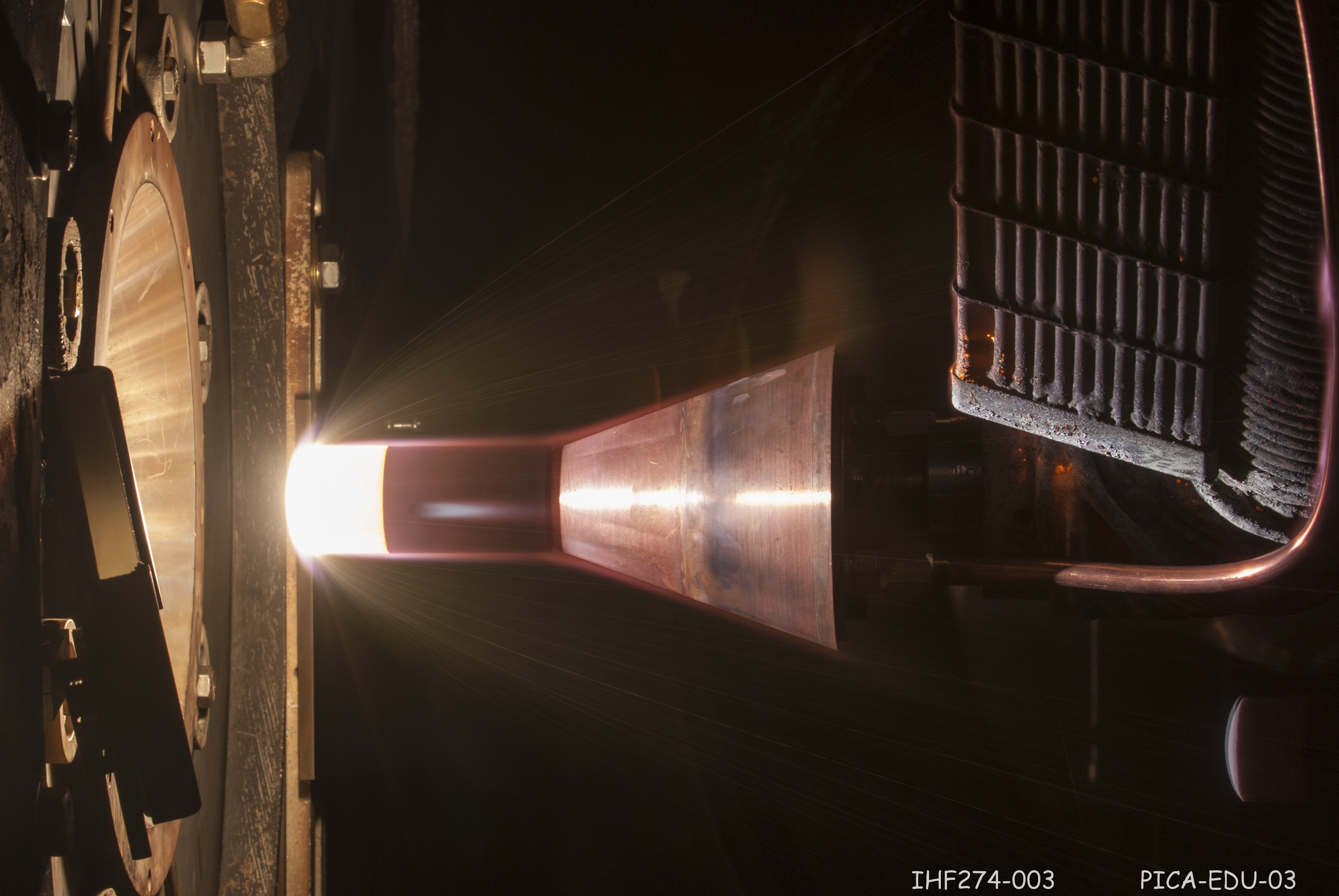
They then worked with mission partner Lockheed Martin Space – who designed and built the spacecraft and capsule – to integrate the air filter and PICA elements onto the mission.
Ames helped qualify the PICA to withstand the extremely high temperatures experienced upon entering Earth’s atmosphere. They provided guidance to the mission on the PICA thickness needed to protect the samples and tested the heat shield material under simulated atmospheric re-entry conditions in Ames’ arc jet facilities to confirm thermal protection performance for the design. Ames experts in computational fluid dynamics supplied analysis that validated the aerothermal environments used in those tests.
Soon after the spacecraft returns, members of Ames’ thermal protection team also plan to laser-scan the OSIRIS-REx heat shield in coordination with colleagues at NASA’s Johnson Space Center in Houston, Lockheed Martin, or both. What they learn about PICA’s performance, relative to predictions, can support future missions such as Mars Sample Return, that will return samples collected by NASA’s Mars Perseverance rover to Earth in the future.
Asteroid Sample Science
When the OSIRIS-REx capsule lands in the Utah desert, researcher Scott Sandford will be on the ground to help retrieve it. The chances of contaminants like soil and water entering the sample canister inside are extremely low. But, to be absolutely certain no one accidentally studies terrestrial materials thinking they are samples from Bennu, he will help collect samples from the environment where the capsule lands, for comparison with the asteroid material.
Later, Sandford will perform scientific studies of the Bennu samples themselves. His study will focus on two areas. He’ll assess what, if any, spacecraft-related contaminants got into the samples, such as material coming off the heat shield as it ablated, or “burned off,” during atmospheric entry. Sandford will also probe the samples for any organic compounds. Scientists estimate that Bennu is 4.5 billion years old and contains well-preserved materials, including complex organics, from the early solar system. Finding organics could tell us something about what roles materials of the early solar system may have played in delivering organic “ingredients of life” to the early Earth.
The techniques Sandford uses will allow him to search for compounds inside the Bennu samples. At Ames he’ll use infrared microspectroscopy to detect various kinds of organics in the samples that contain carbon, hydrogen, nitrogen, and oxygen. He will also work with colleagues to study samples using the Advanced Light Source facility, a specialized particle accelerator that generates bright beams of X-ray light for scientific research, located at Lawrence Berkeley National Laboratory in Berkeley, California. Both techniques provide information about the kinds of chemical bonds present in the samples’ organic compounds.
HORIS: A Study of Atmospheric Entry
NASA’s Langley Research Center in Hampton, Virginia, will manage an experiment taking advantage of the OSIRIS-REx sample arrival to study characteristics of re-entry through an atmosphere.
Four aircraft and teams at three ground sites will track the capsule’s trajectory on its way to the surface, using imaging and spectroscopy instruments. Data from the project, called Hypervelocity OSIRIS-REx Reentry Imaging & Spectroscopy (HORIS), will be used to validate and develop planetary entry models.
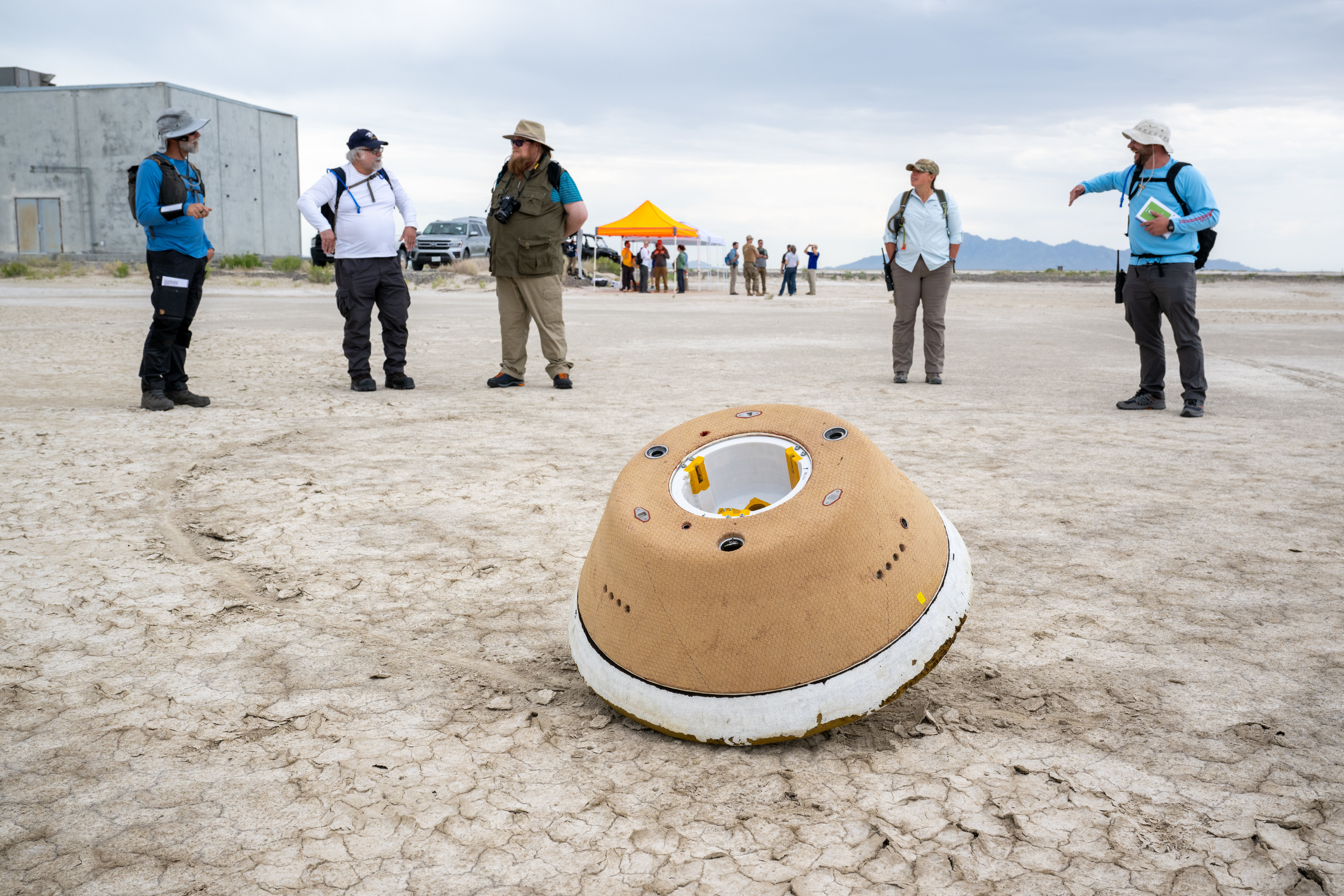
NASA’s Earth Science Project Office (ESPO), based at Ames, will provide operational and shipping support to two international ground teams by setting up work sites at three different locations in northern Nevada.
NASA’s Goddard Space Flight Center in Greenbelt, Maryland, provides overall mission management, systems engineering, and the safety and mission assurance for OSIRIS-REx. Dante Lauretta of the University of Arizona, Tucson, is the principal investigator. The university leads the science team and the mission’s science observation planning and data processing. Lockheed Martin Space in Littleton, Colorado, built the spacecraft and provides flight operations. Goddard and KinetX Aerospace are responsible for navigating the OSIRIS-REx spacecraft. Curation for OSIRIS-REx, including processing the sample when it arrives on Earth, will take place at NASA’s Johnson Space Center in Houston. International partnerships on this mission include the OSIRIS-REx Laser Altimeter instrument from CSA (the Canadian Space Agency) and asteroid sample science collaboration with JAXA’s (the Japan Aerospace Exploration Agency) Hayabusa2 mission. OSIRIS-REx is the third mission in NASA’s New Frontiers Program, managed by NASA’s Marshall Space Flight Center in Huntsville, Alabama, for the agency’s Science Mission Directorate in Washington.
Congratulations to the 2023 Ames Honor Awards Recipients
The honorees will be recognized at the center’s annual Ames Honor Awards ceremony to be held in person on Nov. 1, in the Syvertson Auditorium (N201) at 11 a.m. PDT. Employees are invited to attend as we celebrate, recognize, and honor the achievements of our colleagues. Thank you to everyone who submitted a nomination for this prestigious award, and congratulations to the deserving recipients
Recipients of the 2023 Ames Honor Awards:
Administrative Assistant Support/Secretary
Lyn C. Bartlett
Administrative Professional
Erin K. Contreras
Trincy D. Lewis
Vanessa R. Westmoreland
Best First Paper
Dahlia D. Pham
Evan T. Kawamura
Contractor Employee
Sonja M. Caldwell, KBR
Athena Chan, Science and Technology Corporation
David Garcia Perez, Science and Technology Corporation
Dominic Hart, MORI Associates
Ignacio Gonzalo Lopez-Francos, KBR
Taejin Park, Bay Area Environmental Research Institute
Sasha V. Weston, Millennium Engineering & Integration Co.
Louis W. Wust, InuTeq, LLC.
Diversity, Equity, Inclusion and Accessibility
Kevin L. Jones
Garrett G. Sadler
Dorsa Shirazi
Juan L. Torres-Perez
Education and Outreach
Sarah A. Conley
Denise R. Snow
Engineer
Rodolphe De Rosee
Jesse C. Fusco
Scott T. Miller
Group/Team
Alpha Jet Atmospheric eXperiment (AJAX) Project Team
BioSentinel Mission Operations Team
CapiSorb Visible System ISS Payload & Experiment
ICEE Facility Team
NASA Ames Utility Team
Starling Team
TechEdSat Nano Orbit Workshop
TOSS 4 and RHEL8 Migration Team
VIPER MGRU Rover Team
Voluntary Protection Program Recertification Team
Mentor
Misty D. Davies
Marcie A. Smith
Gloria K. Yamauchi
Partnerships
Sigrid Reinsch
Project Management
Craig D. Burkhard
Kelly E. Kwan
Scientist or Researcher
Thomas P. Greene
Special Appreciation (Non-Ames Employees)
Jeffrey F. Haught, NASA Headquarters
Student
Avraham S. Gileadi, NIFS Intern
Stephanie I. Pass, Intern
Shivang M. Shelat, SJSU Research Foundation
Supervisor/Manager
Susie Go
Lynne H. Martin
Kerry Zarchi
Technical Support/Professional
Randal L. Hobbs
Robert W. Koteskey
Yonghong Shen
Technician
Kevin B. Gregory
Face of NASA: Protocol Officer Carolina Rudisel
“I never would have imagined myself here at NASA. I’m an immigrant. I was originally a Mexican citizen. I was actually born in Mexico, but my parents came over to the U.S. [and I got my green card] when I was two. … My parents originally came over on a worker visa, and so we were migrant workers [when I was] growing up.

“… It was a rough upbringing, and so I knew what my life held for me if I stayed in [my] small town. I knew that I would be stuck, as even now, looking back, some of the people I knew are still stuck. So, I decided that I would join the military because I knew that, for myself, I needed to make a radical change. And so I joined the military, and my life completely turned around. … That’s where I met my husband. We’ve been together 32 years; we’ve been married for 29 years.
“… [Before I joined] the military … I was on the wrong end of the law. I was literally standing in front of a judge who had my fate in their hands. … My recruiter happened to be at my hearing, and so we did a plea bargain and I was let off with a fine. But my life could have been completely different. So I knew the radical change was absolutely necessary for my life.
“… Fast forward: [I] joined the military, got out, and ended up spending most of the time overseas. I lived in Japan — as a matter of fact, both our kids together were born in Japan. [We] lived in Japan, Russia, Sri Lanka, Belgium, and our last post was London.
“… I worked for the Defense Attaché Office, and my co-worker was in the Navy and she was like, ‘There’s a job in NASA in Northern California! You’re from California, right? … You should apply.’ And I [thought], ‘There is no way.’ You know, I’m a businessperson, my background is in business. I was a finance budget analyst. And so, I was like, ‘There’s no way.’ She [said], ‘You should apply. Apply, apply, apply! The worst thing they could say is no.’ And I’m like, ‘You know what? You’re right.’ I applied, came to NASA, [and] actually started off here as the secretary for the center director.
Clues to Psyche Asteroid’s Metallic Nature Found in SOFIA Data
When the asteroid Psyche has its first close-up with a NASA spacecraft, scientists hypothesize they will find a metal-rich asteroid. It could be part or all of the iron-rich interior of a planetesimal, an early planetary building block, that was stripped of its outer rocky shell as it repeatedly collided with other large bodies during the early formation of the solar system.
New research from scientists at NASA’s Ames Research Center in California’s Silicon Valley suggests that is exactly what the agency’s Psyche mission will find.
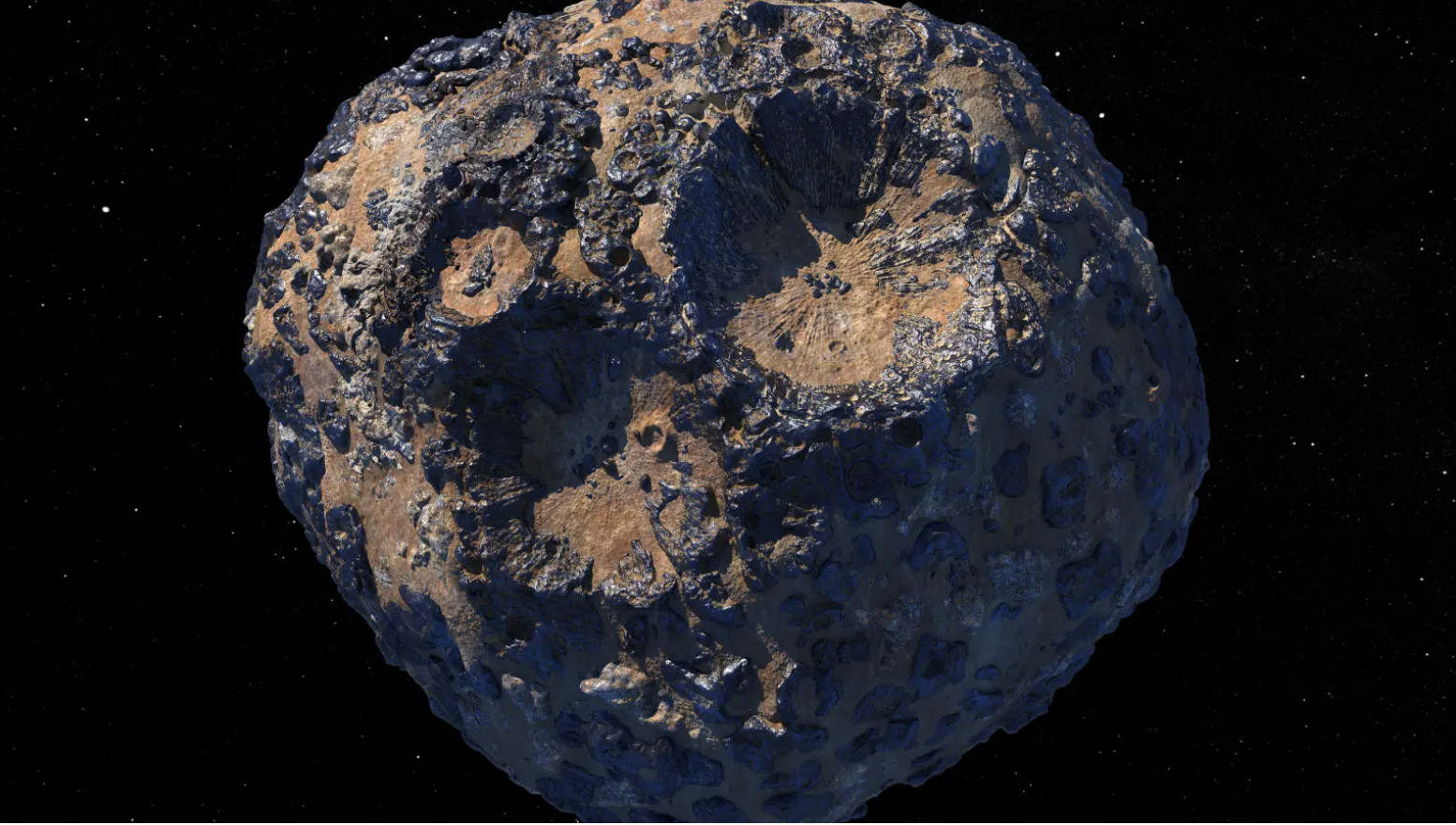
Led by Anicia Arredondo, the paper’s first author and a postdoctoral researcher at the Southwest Research Institute in San Antonio, Texas, and Maggie McAdam, Ames research scientist and principal investigator, the team observed Psyche in Feb. 2022 using NASA’s Stratospheric Observatory for Infrared Astronomy (SOFIA). The now-retired observatory was a Boeing 747SP aircraft modified to carry a reflecting telescope. As a flying telescope, SOFIA collected data that was not affected by Earth’s lower atmosphere and made observations from all over the world, including over the oceans.
For the first time, SOFIA was able to gather data from every part of Psyche’s surface. It also allowed the team to collect data about the materials that make up Psyche’s surface – information that could not be gathered from ground-based telescopes.
The Ames team studied the way different wavelengths of light bounce off Psyche. Researchers used a mid-infrared camera, which detects wavelengths in the middle of the electromagnetic spectrum, to observe the asteroid. They measured its emissivity(the amount of energy it radiates) and porosity (how many tiny holes or spaces an object has). Both characteristics can provide clues about the materials that make up an object.
The team observed that Psyche’s emissivity data was mostly flat, meaning there were no spikes or other notable features in its spectra – that is, a chart or a graph that shows the intensity of light the asteroid emits over a range of energies. Similarly flat spectra have been found in laboratory settings when mid-infrared instruments are used on metal objects. This led the researchers to conclude that Psyche is likely a metallic body.
Notably, the team did not observe a spectral feature called the 10-micron plateau, which typically indicates a “fluffy” surface, like lunar regolith. Previous studies of Psyche had observed this feature, which suggests there may be differences between the surface at Psyche’s north pole, which was facing the Earth at the time of the Ames team’s study, and the surface at its south pole, which was the focus of previous studies. The team also proposed that the south pole regolith observed by other researchers could have been ejected from a collision elsewhere on Psyche’s surface. This idea is supported by past observations of Psyche, which found evidence of huge depressions and impact craters across the asteroid.
“With this analysis and the previous studies of Psyche, we have reached the limit of what astronomical observations can teach us about this fascinating asteroid,” said McAdam. “Now we need to physically visit Psyche to study it up close and learn more about what appears to be a very unique planetary body.” NASA’s mission to Psyche will provide that opportunity. The spacecraft is set to launch on Oct. 12, 2023. It will arrive at the asteroid in 2029 and orbit it for at least 26 months.
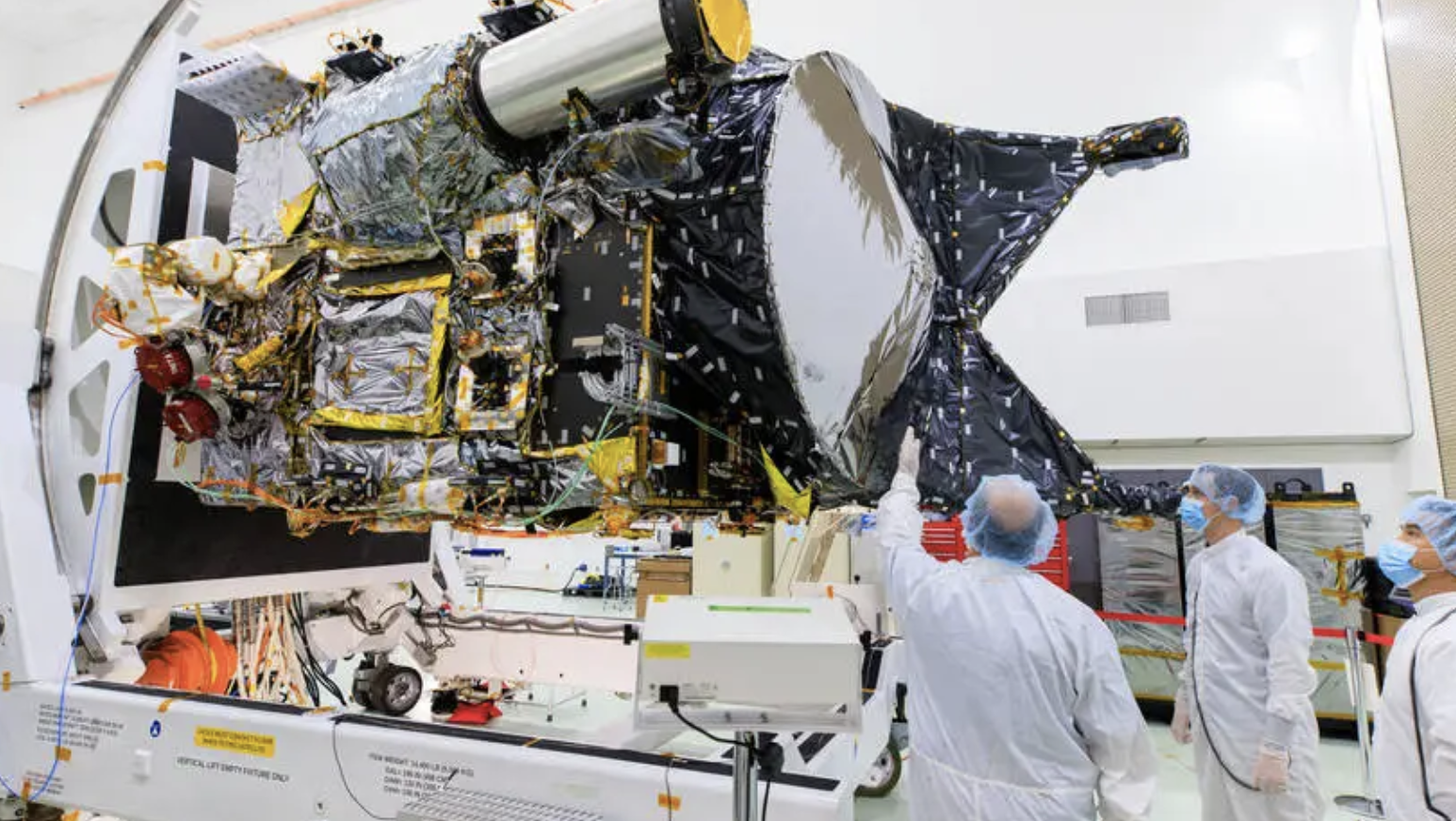
Psyche’s potential to answer many questions about planet formation is a key reason why it was selected for close observation by a spacecraft. Scientists believe that planets like Earth, Mars, and Mercury have metallic cores, but they are buried too far below the planets’ mantles and crusts to see or measure directly. If Psyche is confirmed to be a planetary core, it can help scientists understand what is inside the Earth and other large planetary bodies.
Psyche’s size is also important for advancing scientific understanding of Earth-like planets. It is the largest M-type (metallic) asteroid in our solar system and is long enough to cover the distance from New York City to Baltimore, Maryland. This means Psyche is more likely to show differentiation, which is when the materials inside a planet separate from one another, with the heaviest materials sinking to the middle and forming cores.
“Every time a new study of Psyche is published, it raises more questions,” said Arredondo, who was a postdoctoral researcher at Ames on the SOFIA mission when the Psyche observations were collected. “Our findings suggest the asteroid is very complex and likely holds many other surprises. The possibility of the unexpected is one of the most exciting parts of a mission to study an unexplored body, and we look forward to gaining a more detailed understanding of Psyche’s origins.”
More about the Psyche and SOFIA missions:
Arizona State University leads the Psyche mission. A division of Caltech in Pasadena, JPL is responsible for the mission’s overall management, system engineering, integration and test, and mission operations. Maxar Technologies in Palo Alto, California, provided the high-power solar electric propulsion spacecraft chassis.
Psyche is the 14th mission selected as part of NASA’s Discovery Program, managed by the agency’s Marshall Space Flight Center in Huntsville, Alabama. NASA’s Launch Services Program, based at Kennedy, is managing the launch service.
SOFIA was a joint project of NASA and the German Space Agency at DLR. DLR provided the telescope, scheduled aircraft maintenance, and other support for the mission. NASA’s Ames Research Center in California’s Silicon Valley managed the SOFIA program, science, and mission operations in cooperation with the Universities Space Research Association, headquartered in Columbia, Maryland, and the German SOFIA Institute at the University of Stuttgart. The aircraft was maintained and operated by NASA’s Armstrong Flight Research Center Building 703, in Palmdale, California. SOFIA achieved full operational capability in 2014 and concluded its final science flight on Sept. 29, 2022.
President Biden Lands at NASA Ames, Greeted by Deputy Director
President Joe Biden arrived in California’s Silicon Valley on Tuesday, Sept. 26, 2023, where he was welcomed by Dr. David Korsmeyer, acting deputy center director at NASA Ames and Santa Clara County Supervisor, District 4, Susan Ellenberg. Biden landed aboard Air Force One at Moffett Federal Airfield, located at Ames, before departing for a campaign event in the area.

New Simulations Shed Light on Origins of Saturn’s Rings and Icy Moons
by Frank Tavares
On a clear night, with a decent amateur telescope, Saturn and its series of remarkable rings can be seen from Earth’s surface. But how did those rings come to be? And what can they tell us about Saturn and its moons, one of the potential locations NASA hopes to search for life? A new series of supercomputer simulations has offered an answer to the mystery of the rings’ origins – one that involves a massive collision, back when dinosaurs still roamed the Earth.
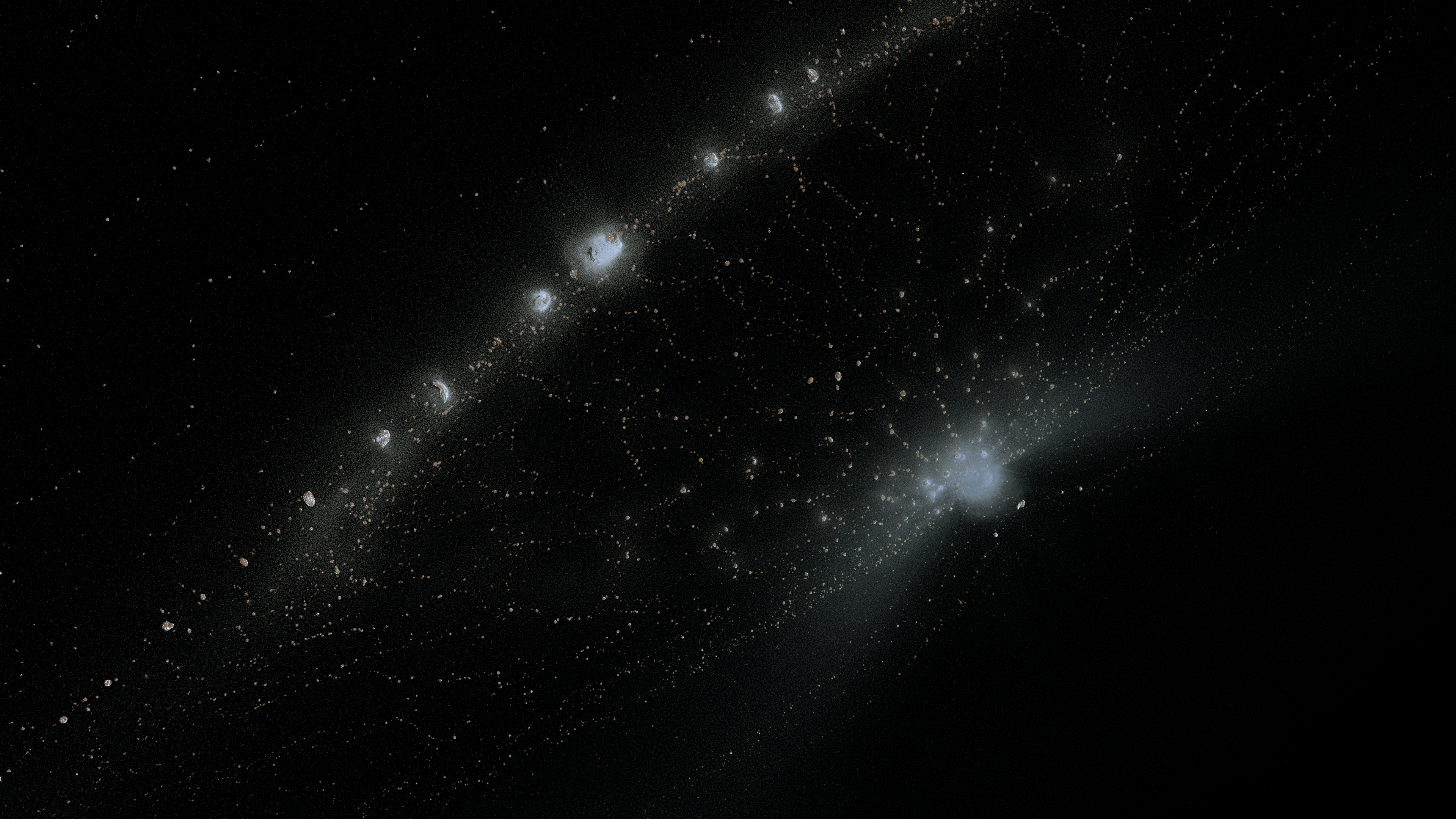
According to new research by NASA and its partners, Saturn’s rings could have evolved from the debris of two icy moons that collided and shattered a few hundred million years ago. Debris that didn’t end up in the rings could also have contributed to the formation of some of Saturn’s present-day moons.
“There’s so much we still don’t know about the Saturn system, including its moons that host environments that might be suitable for life,” said Jacob Kegerreis, a research scientist at NASA’s Ames Research Center in California’s Silicon Valley. “So, it’s exciting to use big simulations like these to explore in detail how they could have evolved.”
NASA’s Cassini mission helped scientists understand just how young – astronomically speaking – Saturn’s rings and probably some of its moons are. And that knowledge opened up new questions about how they formed.
To learn more, the research team turned to the Durham University location of the Distributed Research using Advanced Computing (DiRAC) supercomputing facility in the United Kingdom. They modeled what different collisions between precursor moons might have looked like. These simulations were conducted at a resolution more than 100 times higher than previous such studies, using the open-source simulation code, SWIFT, and giving scientists their best insights into the Saturn system’s history.
Saturn’s rings today live close to the planet, within what’s known as the Roche limit – the farthest orbit where a planet’s gravitational force is powerful enough to disintegrate larger bodies of rock or ice that get any closer. Material orbiting farther out could clump together to form moons.
By simulating almost 200 different versions of the impact, the team discovered that a wide range of collision scenarios could scatter the right amount of ice into Saturn’s Roche limit, where it could settle into rings.
And, while alternative explanations haven’t been able to show why there would be almost no rock in Saturn’s rings – they are made almost entirely of chunks of ice – this type of collision could explain that.
“This scenario naturally leads to ice-rich rings,” said Vincent Eke, Associate Professor in the Department of Physics/Institute for Computational Cosmology, at Durham University and a co-author on the paper. “When the icy progenitor moons smash into one another, the rock in the cores of the colliding bodies is dispersed less widely than the overlying ice.”
Ice and rocky debris would also have hit other moons in the system, potentially causing a cascade of collisions. Such a multiplying effect could have disrupted any other precursor moons outside the rings, out of which today’s moons could have formed.
But what could have set these events in motion, in the first place? Two of Saturn’s former moons could have been pushed into a collision by the usually small effects of the Sun’s gravity “adding up” to destabilize their orbits around the planet. In the right configuration of orbits, the extra pull from the Sun can have a snowballing effect – a “resonance” – that elongates and tilts the moons’ usually circular and flat orbits until their paths cross, resulting in a high-speed impact.
Saturn’s moon Rhea today orbits just beyond where a moon would encounter this resonance. Like the Earth’s Moon, Saturn’s satellites migrate outward from the planet over time. So, if Rhea were ancient, it would have crossed the resonance in the recent past. However, Rhea’s orbit is very circular and flat. This suggests that it did not experience the destabilizing effects of the resonance and, instead, formed more recently.
The new research aligns with evidence that Saturn’s rings formed recently, but there are still big open questions. If at least some of the icy moons of Saturn are also young, then what could that mean for the potential for life in the oceans under the surface of worlds like Enceladus? Can we unravel the full story from the planet’s original system, before the impact, through to the present day? Future research building on this work will help us learn more about this fascinating planet and the icy worlds that orbit it.
Statistical Summary of Activities of the Protective Service Division’s Security/Law Enforcement and Fire Protection Services Units for Period Ending August 2023
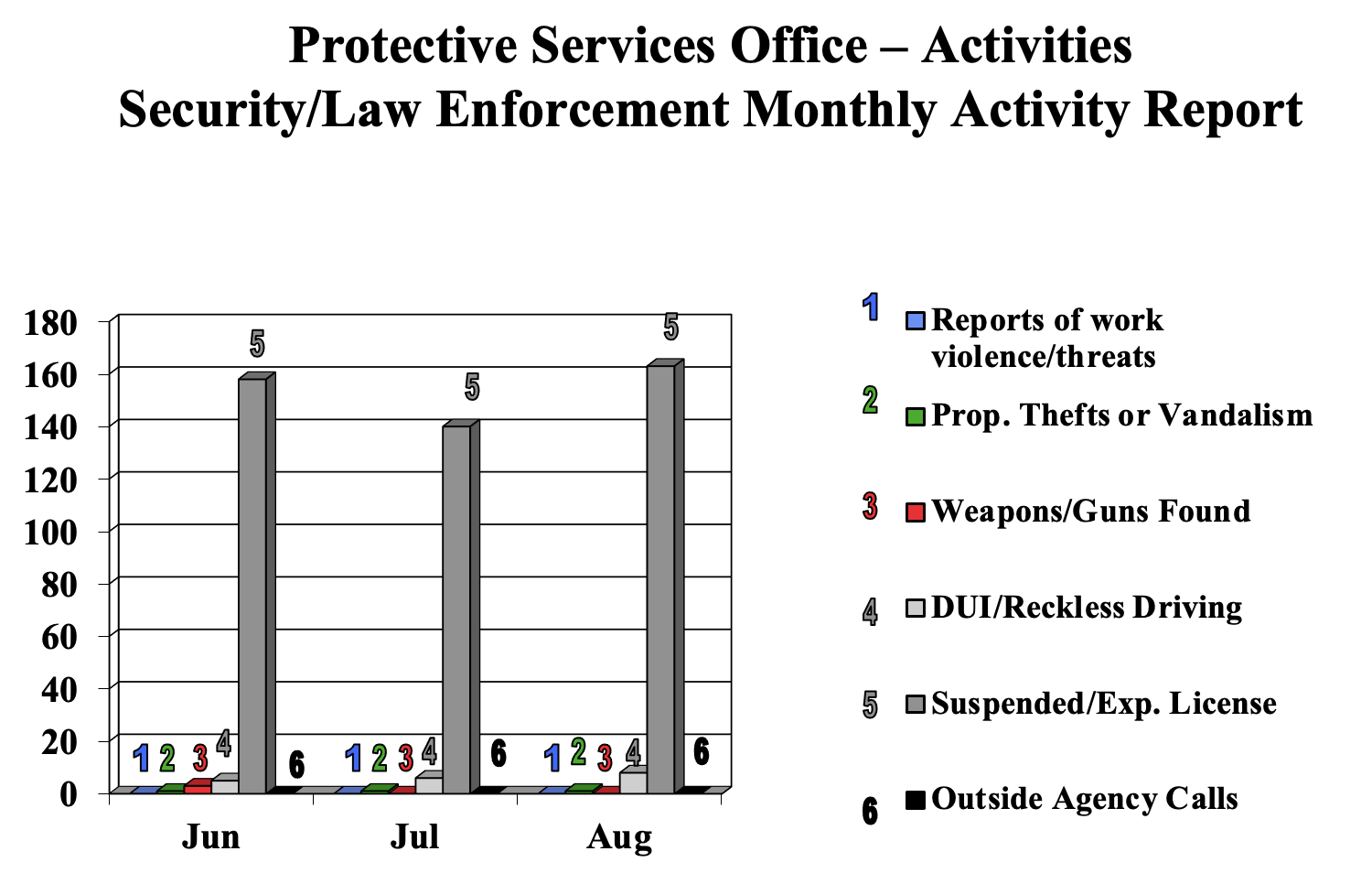
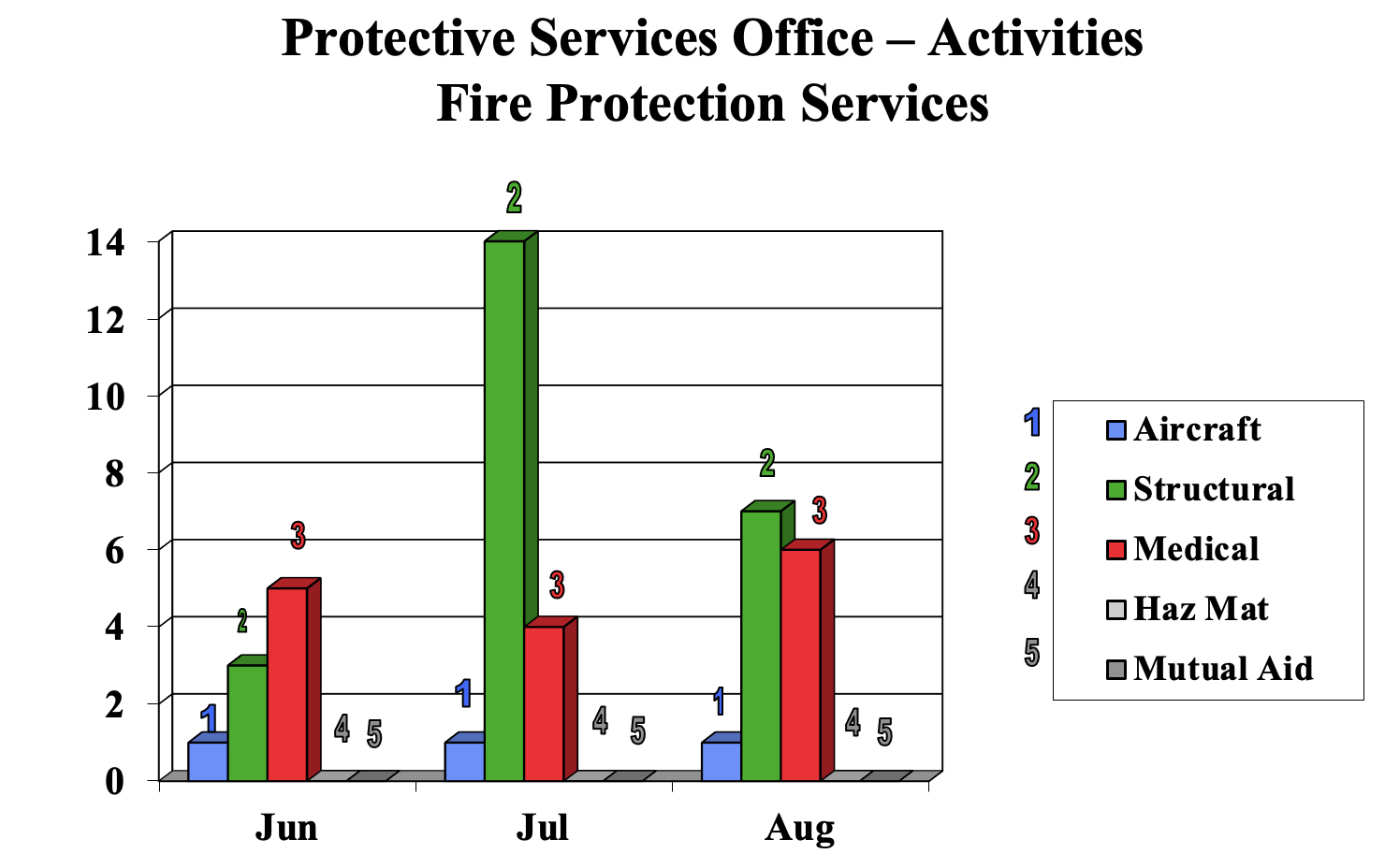
Powered by WPeMatico
Get The Details…
Astrid Albaugh



